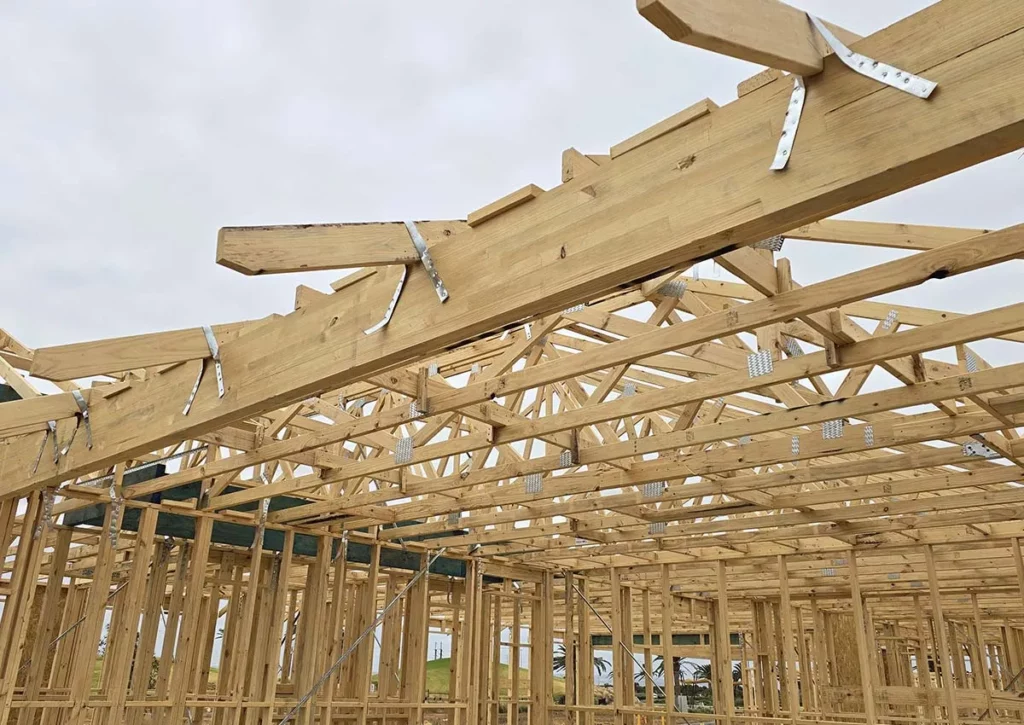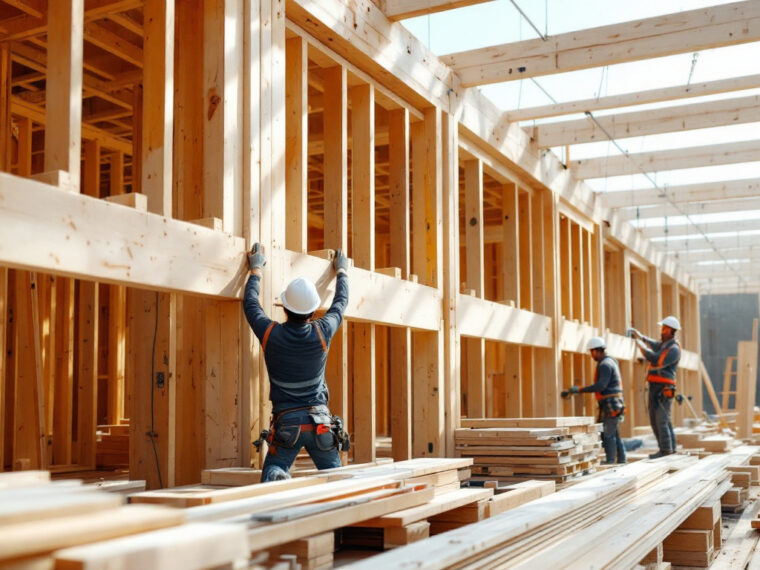What is LVL Formwork Timber and How is It Manufactured?
Laminated Veneer Lumber (LVL) represents a significant advancement in engineered wood products, specifically designed for construction formwork applications. This innovative material consists of multiple layers of thin wood veneers, precisely bonded together using high-strength adhesives under intense heat and pressure.
The Manufacturing Process:
- Timber logs are carefully peeled into thin veneers (typically 3mm thick)
- Each veneer undergoes rigorous quality inspection
- Selected veneers are dried to specific moisture content
- Industrial-grade adhesives are applied between layers
- Veneers are stacked with grain direction aligned parallel
- Heat and pressure are applied to create permanent bonds
The resulting LVL formwork timber exhibits remarkable uniformity throughout its structure. Unlike traditional solid wood formwork, LVL eliminates natural defects such as knots and irregular grain patterns that can lead to weak points.
Key Characteristics:
- Consistent density across the entire panel
- Uniform load-bearing capacity
- Minimal natural variations
- Superior dimensional stability
- Reduced tendency to warp or twist
The lamination process creates a product that’s significantly stronger than conventional timber formwork. Each veneer layer works in harmony with adjacent layers, distributing forces evenly across the material’s structure. This engineered approach produces formwork that’s both reliable and predictable in performance, making it an ideal choice for modern construction projects.

How Does LVL Formwork Timber Provide Superior Strength for Construction?
LVL formwork timber’s exceptional strength comes from its unique layered construction. The way the wood veneers are arranged in parallel creates a system that evenly distributes force, preventing points of stress during concrete curing. This design allows LVL to handle pressures up to 65 kPa – significantly higher than traditional timber formwork.
Resistance to Common Deformation Issues
The engineered nature of LVL provides excellent resistance to common deformation problems:
- Warping Resistance: The cross-laminated structure maintains dimensional stability under varying moisture conditions
- Twisting Prevention: Multiple bonded layers restrict movement, keeping forms straight and true
- Load Distribution: Uniform veneer arrangement spreads pressure evenly across the entire surface
Versatile Applications in Construction
LVL formwork is highly versatile and can be used in various construction applications:
- Vertical wall forms up to 6 metres high
- Horizontal slab supports spanning 4.5 metres
- Load-bearing beam structures
- Heavy-duty scaffolding systems
Advantages in High-Rise Construction
The material’s high strength-to-weight ratio makes it especially valuable in high-rise construction projects. A single LVL panel can support concrete loads equivalent to 6,500 kg/m², allowing for faster pouring rates and reduced support requirements. Learn more about strength on https://pmc.ncbi.nlm.nih.gov/articles/PMC5583434/
Consistent Quality through Precision Manufacturing
The precise manufacturing process used for LVL eliminates natural wood defects such as knots and grain irregularities. This results in a consistently strong product that maintains its structural integrity throughout multiple concrete pours, minimizing the risk of formwork failure during critical construction phases.
How Does LVL Formwork Timber Offer Enhanced Durability on Site?
LVL formwork timber is incredibly resistant to tough conditions on construction sites. Its engineered design creates a strong barrier against moisture, preventing water from getting in and causing damage or mould growth. Unlike regular plywood, LVL stays strong even when exposed to rain or high humidity.
Benefits of LVL’s UV-Resistant Properties
The UV-resistant features of LVL formwork stop surface deterioration and splitting that are common with traditional timber products. This resistance leads to:
- Minimal surface checking
- Reduced edge wear
- Consistent performance across multiple uses
Proper Maintenance Practices
To ensure the longevity of LVL formwork, it is essential to follow these proper maintenance practices:
- Clean surfaces immediately after stripping
- Remove concrete residue with appropriate scrapers
- Store panels flat on level ground
- Keep materials covered when not in use
Preventing Common Formwork Issues with LVL’s Engineered Composition
The engineered composition of LVL significantly reduces common problems encountered during concrete pours. The material’s dimensional stability prevents:
- Edge crushing under pressure
- Panel sagging between supports
- Corner damage during handling
LVL formwork retains its shape throughout multiple uses, resulting in consistent concrete finishes without the need for frequent replacements. This durability comes from its precise manufacturing – each layer of veneer adds strength while eliminating natural wood defects that often lead to early failure in traditional formwork materials. Click here to find more about durability.
Regular Inspection Protocols for Maintaining Performance
Regular inspection protocols help identify potential wear points before they affect performance. Construction teams should check for:
- Surface damage
- Signs of delamination
- Edge condition
- Hardware attachment points
How Does the Cost of LVL Formwork Compare to Traditional Materials?
LVL formwork requires an initial investment that is 15-25% higher than traditional plywood options. A standard 2400mm x 1200mm LVL panel costs around AUD 180-220, while the cost of equivalent traditional formwork plywood ranges from AUD 150-175.
However, when we look at the long-term benefits, LVL formwork proves to be more cost-effective:
1. Reusability Rate
- LVL: 20-25 uses per panel
- Traditional Plywood: 8-12 uses per panel
2. Labour Efficiency
- 30% faster assembly time
- 25% reduction in worker hours
- Lightweight design reduces physical strain
3. Support Structure Savings
- 40% fewer support beams required
- Reduced scaffolding needs
- Minimized bracing requirements
The superior strength-to-weight ratio of LVL formwork leads to significant cost savings in additional materials. For a typical 200m² commercial project, the following resources are needed:
Traditional Plywood Setup:
- 45 support beams
- 180 bracing points
- 12 workers for installation
LVL Setup:
- 27 support beams
- 108 bracing points
- 9 workers for installation
These efficiencies result in approximately a 20% reduction in total project formwork costs when considering labour, materials, and time savings across multiple uses.
What Environmental Benefits Does LVL Formwork Timber Provide?
LVL formwork timber stands out as a sustainable choice in construction, maximising timber resource utilisation through its innovative manufacturing process. The production method creates 90% less waste compared to traditional solid wood products, as manufacturers can use smaller diameter logs and transform them into high-strength components.
The environmental advantages of LVL formwork include:
- Efficient Material Use: A single log yields multiple thin veneers, creating more usable product from each harvested tree
- Minimal Manufacturing Waste: Wood remnants become biofuel for production facilities
- Reduced Transportation Impact: Lighter weight means lower fuel consumption during delivery
Leading LVL manufacturers maintain strict sustainability certifications:
- Sustainable Forestry Initiative (SFI)
- Programme for the Endorsement of Forest Certification (PEFC)
- Forest Stewardship Council (FSC)
These certifications ensure responsible forest management practices and chain-of-custody tracking from harvest to end-use.
The carbon footprint of LVL formwork presents significant advantages over steel alternatives. Steel formwork production generates approximately 2.5 times more carbon emissions than LVL manufacturing. Trees used in LVL production also act as carbon sinks during growth, storing approximately 1 tonne of CO2 per cubic metre of finished product.
Research indicates LVL formwork’s embodied energy measures at 11 MJ/kg, compared to steel formwork at 32 MJ/kg, demonstrating clear environmental benefits for construction projects prioritising sustainability.
How Should LVL Formwork Timber Be Installed for Maximum Strength and Efficiency?
Proper installation of LVL formwork timber demands strict adherence to Australian construction standards and best practices. The orientation choice – vertical or horizontal – directly impacts the formwork’s load-bearing capacity.
Vertical Installation
- Space supports at 400mm centres maximum
- Secure top and bottom plates with 14-gauge screws
- Use double studs at panel joints
- Install lateral bracing every 2.4m in height
Horizontal Installation
- Position bearers at 600mm maximum centres
- Apply structural adhesive between joints
- Install blocking at mid-span for spans over 3m
- Use galvanised brackets at connections
Size Selection Guidelines
- 45mm thickness for standard wall heights up to 3m
- 63mm thickness for heights up to 4.5m
- 75mm thickness for specialised applications
Critical Fixing Methods
- Pre-drill holes to prevent splitting
- Use hot-dipped galvanised fasteners
- Install washers under bolt heads
- Maintain 30mm edge distance for fixings
The structural integrity of LVL formwork relies on precise fixing techniques. Each connection point must transfer loads effectively through the system. Regular inspection during installation helps identify potential weak spots before concrete pouring begins.
What Maintenance Practices Extend the Lifespan of LVL Formwork Timber?
Regular maintenance of LVL formwork timber creates substantial cost savings through extended reuse cycles. A structured inspection routine includes:
- Checking for surface damage after each use
- Examining edge conditions for delamination
- Inspecting fixing points for signs of weakness
- Testing surface hardness with simple scratch tests
Essential Cleaning Protocol:
- Remove concrete residue within 24 hours of stripping
- Use plastic scrapers to prevent surface damage
- Apply release agent before next use
- Clean tie holes and edges thoroughly
Proper storage practices protect your investment:
- Stack panels horizontally on level ground
- Place supports at 600mm intervals
- Keep panels under shelter away from direct sunlight
- Maintain air circulation between stacked panels
- Use protective covers during extended storage periods
These maintenance practices deliver tangible benefits:
- Reduced replacement costs
- Consistent concrete finish quality
- Improved workplace safety
- Extended service life up to 20+ uses
- Maintained structural integrity between pours
A dedicated maintenance schedule transforms LVL formwork from a consumable item into a valuable long-term asset for your construction projects.
How Does LVL Formwork Integration Impact Overall Project Costs in Australian Construction?
The Australian construction industry faces significant cost pressures due to rising material prices. LVL formwork emerges as a strategic choice for project cost management through its durability and performance benefits.
Material Cost Analysis:
- Initial LVL investment: 15-20% higher than traditional plywood
- Reuse capacity: 15-20 times compared to 5-8 times for standard formwork
- Extended lifespan reduces replacement frequency by 60%
Labour Cost Reductions:
- 25% faster installation time
- Reduced worker fatigue due to lighter weight
- Minimal adjustments needed during concrete pours
The superior strength of LVL formwork eliminates the need for additional support structures. A typical 200m² commercial project requires:
- 40% fewer support beams
- 30% reduction in bracing requirements
- Decreased scaffolding hire costs
Real-World Cost Comparison:
A recent Melbourne high-rise project demonstrated significant savings:
- Traditional formwork system: $85/m²
- LVL formwork system: $65/m² (factoring multiple uses)
- Net savings: $20/m² on formwork costs
The structural integrity of LVL minimises concrete wastage and rework requirements. Construction teams report reduced material losses and fewer quality-related delays, contributing to better project cost control.
Recent market analysis shows LVL formwork can achieve 15-20% cost savings across entire project lifecycles when compared to conventional alternatives. These savings become particularly significant in large-scale developments where formwork represents 40-60% of concrete structure costs.
Is LVL Formwork Timber the Right Choice for Your Next Construction Project?
LVL formwork timber is a game-changing solution for construction projects in Australia. Its engineered strength, exceptional durability, and cost-effectiveness make it an ideal choice for builders seeking reliable formwork solutions.
Key advantages that set LVL formwork apart:
- Superior load-bearing capacity
- Resistance to warping and deformation
- Extended lifespan through multiple reuses
- Reduced labour costs during installation
- Environmental sustainability credentials
These benefits make LVL formwork timber a compelling choice in modern construction. Projects that require precise concrete finishes, structural integrity, and efficient resource use will greatly benefit from LVL formwork timber. Investing in LVL formwork not only improves performance but also saves costs in the long run, making it a smart choice for construction projects of any size.

